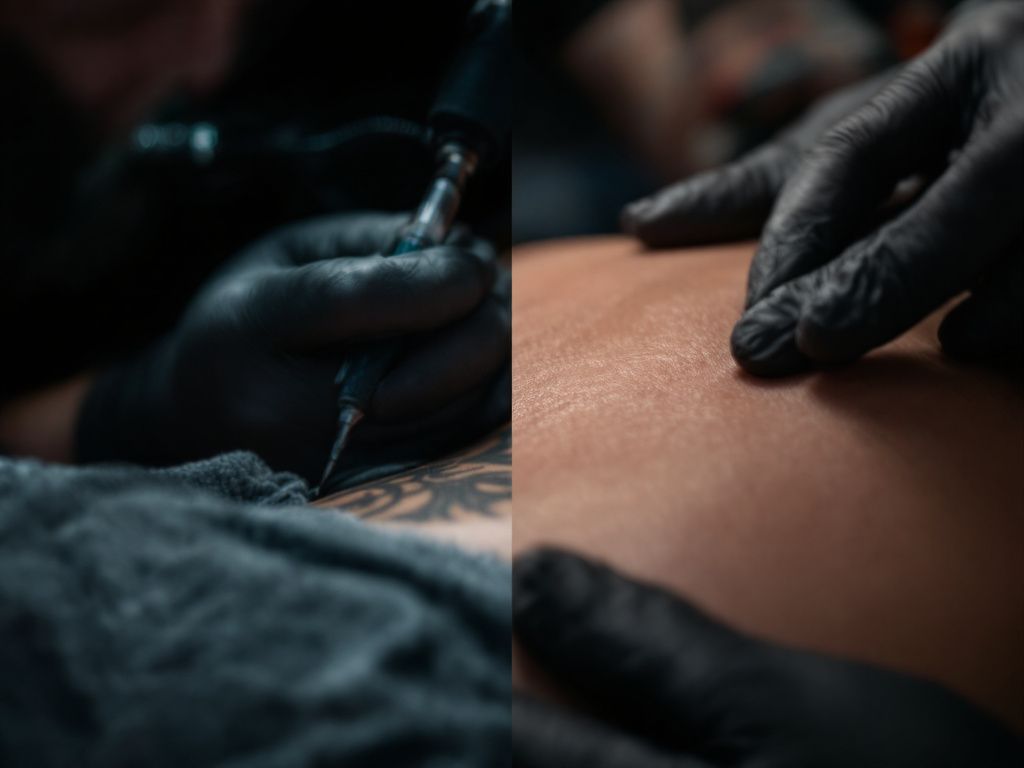Let’s dive right into it—tattooing is an art like no other. It’s creating masterpieces on the living canvas of human skin. But here’s a burning question in the mind of every artist: How do you ensure the best work on different skin types while keeping everything under a sterile environment? Navigating the myriad skin varieties is essential, and that’s what we’re tackling today.
**Understanding Your Canvas: The Human Skin**
Before we even talk about the needles and inks, let’s hit the basics. The human skin isn’t uniform, far from it actually. You’ve got to consider factors like skin tone, elasticity, and even underlying health conditions. Each one can completely impact how your ink sits and how your masterpiece eventually heals.
Different skin types mean different challenges. Ever tried tattooing on scarred skin? It’s another ball game entirely, and sun-damaged skin? Yet another story. Say you’re lining up for an intricate design on someone with sensitive skin—that’s another scope of work altogether. We’ll get into these details, but first, let’s discuss setting up the most crucial part of tattooing: a sterile environment.
Creating the Optimal Tattooing Environment
Why a Sterile Environment is Non-Negotiable
Listen, tattooing isn’t just about creativity; it’s as much about safety and hygiene. Can we agree on that? Ensuring a sterile environment is paramount. It’s protecting your client’s health and your reputation. Nobody wants to be “that artist” with horror story clients blaming them for infections, right?
Steps to Maintain Sterility in Your Studio
- Clean and Disinfect: Before any art starts, make sure your workspace is clinically clean. Disinfect surfaces and sterilize your tools. Organize your workspace so everything you need is intuitive to reach without unnecessary movement, reducing contamination risks.
- Use Single-Use Materials: This one’s a no-brainer—disposable needles, ink caps, gloves. Use fresh materials for every client and dispose of them immediately after use. Technological advancements and ready options make it easier than ever to maintain this practice.
- Barrier Protection: Cover any equipment you touch frequently with barriers. That tattoo machine you’re using? Wrap it up! Same goes for clip cords and light switches.
- Personal Hygiene: Practice what you preach. Maintain personal hygiene with sanitized hands, a mask (especially if you’re prone to sneezes), and clean, comfortable attire.
- 5. **Client Communication: Keep your clients in the loop about why these practices matter. It reinforces your professionalism.
Navigating Different Skin Types

Understanding the skin like an artist’s palette—each element enhances or challenges the creative process.
Dealing with Sensitive Skin
Some folks have skin that reacts at the drop of a hat. Red, inflamed, even breaking out into hives. If this sounds like your next client, go slow and steady. Gently does it—explain and give them breaks if they’re feeling uncomfortable.
Tattooing Older Skin
With age, skin thins, losing elasticity which changes the terrain altogether. Here, your best bet is to pull the skin taut and use designs that don’t rely heavily on crisp outlines. This minimizes the need for touch-ups.
Working on Scarred or Damaged Skin
Scars create quite an interesting topography, right? While they pose a challenge, creative tattoo artists use them to the artwork’s advantage. Test a patch first, ensuring the skin can handle the piercing trauma without improper scarring or ink damage.

Dark vs. Fair Skin
Ink shows up differently on a continuum of skin colors. For darker skin, choose bold lines and simpler designs to avoid a muddy look post-healing. Fair skin gives more leeway with pastel and softer shades; however, always be cautious of sun damage post-tattoo.
Tattooing Over Tattoos
Cover-ups—there’s an art to these! Keep them exciting by considering how old ink affects new designs, in terms of both placement and ink choice.
Step-by-Step: Crafting Art Night After Night
Practical advice time—how do we tie the skin type and sterile environment into working effectively every single time?
Step One: Consult Thoroughly
Have a conversation with your client about their skin history, any known allergies, reactions, or recent sun exposure. Knowing if they battle work acne lets you better choose how to prepare their skin—or advise them to treat the acne first before tattooing.
Step Two: Skin Prep Like a Pro
Clean and shave the area thoroughly. Applying a gentle, non-irritating antibacterial wipe preps the skin against infection while keeping inflammation at bay. Listen, acne isn’t easy to handle when tattooing, but nothing a little planning can’t prep.
Step Three: Adjust Your Technique

- Tattoo on Hydrated Skin: Well-moisturized skin handles ink better and heals faster. Remind clients to moisturize, avoiding oil-based or fragrant products that might irritate.
- Needle Choice and Depth: Personalize this based on skin texture and elasticity. Adjust settings on your machine to adapt.
Step Four: Post-Tattoo Care
Tag along with your client in their healing journey:
- Set the stage for success. Educate on caring for work acne, sun avoidance, keeping the tattoo moisturized, breathable, and clean.
Step Five: Follow-up
A week later, circle back for feedback. Does your client have additional skin reactions or healing issues? Always factor in post-care products suggested for work acne; your insight could save their skin serenity.
Key Takeaways
- Every Skin is Unique: Love it or loathe it, this variation is your reality.
- Disciplined, Sterile Environment: Essential for artistry and reputation.
- Adapt & Adjust Techniques: Tailor your routine, from consultation through to aftercare, based on skin needs.
- Continuous Client Engagement: That trust journey engages confidence, creating repeat business and rave reviews.
Wrapping it All Together
There’s an art to managing your work as a tattoo artist beyond the physical act of tattooing. It’s connecting with clients, accommodating their needs, and creating standout art defined by understanding and care. Mistakes—well, who doesn’t make them? They help us hone our craft.
Stay curious. Keep learning. And trust me on this, when in doubt: consult on the side of caution, care, and creativity. Your client’s skin, after all, is your permanent, living gallery. Consider yourself custodians of this traveling gallery and do what it takes to treasure it. You’re the maestro. Confident, safe, and prepared to paint on any canvas—nothing should stop your groove!
Frequently Asked Questions
What causes acne in the workplace or during daily activities?
Acne can be caused by a combination of factors including hormonal changes, stress, and the use of certain skin care products or cosmetics. In the workplace, stress and the use of non-comedogenic skin care products can play a significant role. Hormonal fluctuations, such as those experienced during puberty, pregnancy, or due to certain medical conditions, can also trigger acne[1][3].
How does diet impact acne?
Diet can contribute to the development or worsening of acne. Foods with a high glycemic load, such as white bread and white potatoes, can cause blood sugar levels to rise quickly, which may exacerbate acne. Additionally, the consumption of cow’s milk, particularly skim milk, has been linked to acne in some studies[1][3].
Can certain medications or drugs trigger acne?
Yes, certain medications and drugs can trigger acne. These include corticosteroids, anabolic steroids, and some medications used to treat depression, bipolar disorder, and epilepsy. These substances can affect hormone levels, leading to increased sebum production and acne[1][3].
How can I manage acne in my daily life and at work?
To manage acne, it is important to maintain good skin hygiene without over-washing, use non-comedogenic skin care products, and avoid picking or squeezing acne lesions. Early treatment and consulting a doctor for appropriate medications or treatments can also help prevent severe acne and scarring. Reducing stress through relaxation techniques may also help alleviate acne symptoms[1][3][5].
References










